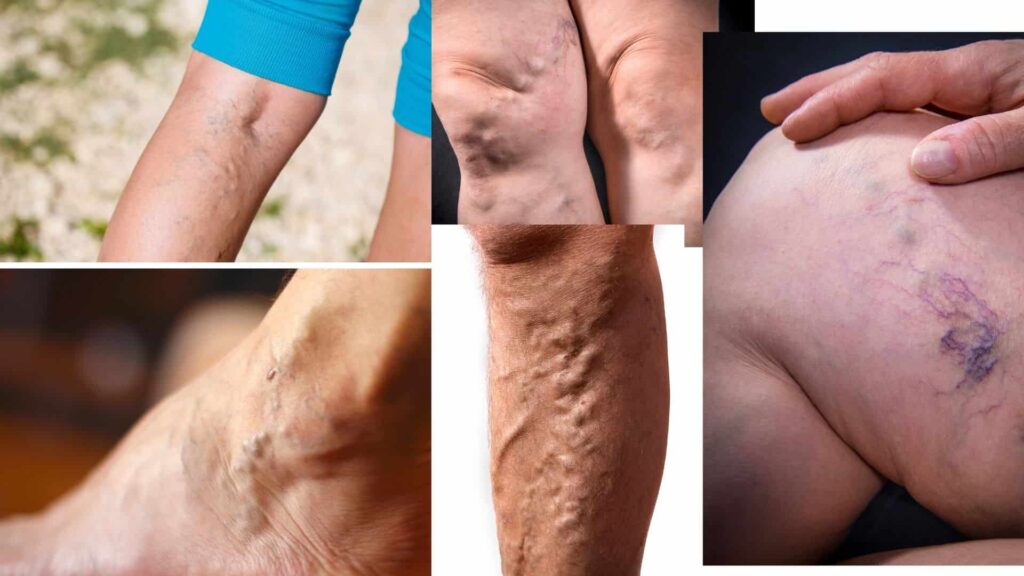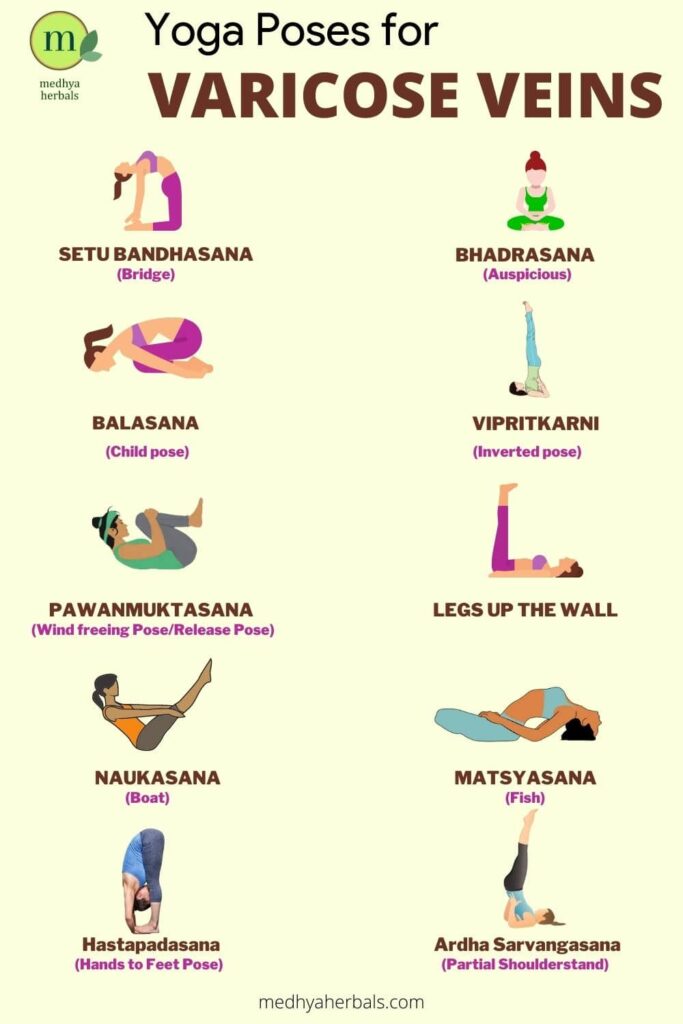Varicose veins occur when your veins become dilated (swollen), enlarged, and clogged with blood. Ayurvedic treatment for varicose veins focuses on holistic management of the condition.
Ayurveda suggests suitable changes in diet and lifestyle along with your symptoms specific herbs to find relief from varicosity of the veins.
What are varicose veins?
Veins are blood vessels that return blood to the heart after they have gone through circulation. A varicose vein is an enlarged, swollen, twisted vein. This may also show appearance of dark blue or purple discoloration of the skin around the affected veins.
Varicosity usually affects the veins of hands and feet. Mostly, the legs are more prone to having varicose veins. This is because the veins of the extremities (hands and feet) are farthest from the heart. Hence, they find it more difficult to return blood to the heart.
What causes Varicosity of the Veins?
Varicosity in the veins can happen due to primary or secondary factors.
Primary being the main reason of the health disorder. For example, excess weight or standing for long hours.
And secondary means that varicosity happened due to something else that made a patient prone to varicose veins. For example, hormonal changes in Menopause or during pregnancy. Now, let’s try to understand what’s happening with your veins:
- Poor Circulation in the veins
- Valve malfunction due to weakening of the valves
- Accumulation of toxins in the blood stream
- Poor strength of the venous walls
Let’s look into the above three factors in detail. This is because once you understand what’s happening, you can prevent varicose veins from happening.
How do Varicose Veins Develop? Different Stages and Symptoms
This part is also available in video format here.
Our veins consist of several one-way valves. These valves only allow the blood to move upwards. And they close down, once blood flows through. Thus, preventing backward flow of the blood.
During good circulation, the muscular contractions of the leg muscles assist the blood in moving up. Additionally, any physical activity or movement of the muscles squishes the blood upwards the vein. The valves allow the blood up. This is done at successive valves going up the vein.

Stage 1
According to Ayurveda, Vyana Vata is responsible for flow of blood to-and-fro from the heart to the limbs. Hence, an imbalance in Vyana vata leads to poor circulation through the veins.
Poor circulation often leads to excessive pressure on the venous walls and valves. This leads to fatigue and malfunctioning of the valves and veins. Hence, the valves do not fit tightly anymore. Also, the venous walls lose their elasticity. They tend to bulge and buckle down under the pressure of clogged up blood.
This leads to back up of blood and clogging up of the veins, resulting in observed symptoms of varicose veins such as:
- Lack of sensation and numbness in the area
- Tingling
- Swelling
- Light pain that comes and goes
- Inability to stand for long hours
- Slight discoloration and bulging of the veins
Stage 2
Now, if the condition is not treated at this stage then it progresses further. Clogged up blood starts to bypass the valves and collects in the superficial veins of the legs. These are closer to the skin and have less muscular support than the deep veins.
This leads to typical discolored and or painful spider veins. At stage 2, the physical appearance becomes prominent. Other symptoms that appeared in stage 1 may be more aggravated by now.
Stage 3
In stage 3, the clogged up blood in the venous walls start to deteriorate under Ranjaka Pitta. This happens when one develops Pitta imbalance due to high heat or poor liver function.
The blood thickens up due to presence of toxins or waste materials “Ama”. This further slows down the circulation and aggravates symptoms of varicose veins.
This leads to symptoms such as:
- Inflammation, heat, and extreme pain
- Peeling of the skin
- Wounds and presence of ulcers
- Skin being prone to infections
- Swelling and numbness
Who are prone to develop Varicose Veins?
As stated above, Varicose veins develop due to accumulation of toxins and an imbalance in Dosha. Hence, one becomes prone to varicosity due to following factors:
- Hormonal Shifts during Menopause and Pregnancy
- During old age, when Vata Dosha naturally rises leading to dryness in the body and slowing down of muscular activity
- Poor functioning of liver and spleen leading to imbalance in Pitta Dosha
- Poor Diet and Lifestyle, which creates toxin-build up in the body
- Excessive pressure on the lower limbs due to extended sitting hours, heavy body (obesity), or extended standing hours
- Wearing tight clothing, which restricts circulation of the blood
- Absence of physical activity, which leads to low or no muscular push to blood through the valves
- Nutritional deficiencies, specifically related to B Vitamins, Vitamin C, Magnesium, Calcium, and Potassium that affect functioning of the muscles.
Symptoms of varicose veins
The symptoms of varicosity in the veins depends on the stage of imbalances and involved Dosha. Hence, any two persons may have different symptoms, place of varicosity of veins, and extent of the symptoms. However, most common health issues that accompany varicose veins are:
- Aching, throbbing legs and swollen ankles.
- Twisted, bulging veins
- Telangiectasia- spider web veins.
- Heaviness that is most pronounced after exercise or at night.
- Bluish/dark-purplish discoloration.
- Leg muscle cramps, especially at night.
- Irregular whitish patches that resemble scars at the ankles.
Further complications that might arise due to varicose veins
When varicose veins are not treated in time, it may lead to health complications. People with this condition are more likely to develop following health issues:
- Bleeding;
- Thrombophlebitis- clots in leg vein that cause inflammation of vein;
- Chronic venous insufficiency.
- Deep Venous Thrombosis(DVT).
- Lymphatic disorders, etc.
Ayurvedic Treatment of Varicose Veins
Ayurvedic treatment for varicose veins focus on strengthening the circulatory system and also to flush the toxins out of the body. A series of diet and lifestyle changes along with physical treatment and herbal solutions is offered to cure the issue from the roots.
Following therapies are employed depending on the stage of the varicose veins:
- Panchakarma therapy to flush the toxins out and balance the three Dosha. It is a 5 step cleanse procedure that focuses on establishing the digestive fire, improving circulation of blood, and improving the functioning of liver and kidneys.
- Abhyanga: This is an Ayurvedic massage therapy. Use jojoba and sesame oils to massage for good results. Also, swedana uses steam to stimulate the upwards flow of blood in the legs.
- Another option is to wear veshtana. Wound this tightly around the affected leg. It helps relieve heaviness, numbness and pain.
- Yoga therapy that focuses on improving blood circulation, repairing valve function, and strengthening the muscles.
- Adaptation in diet and lifestyle to remove the cause of imbalances and toxin build up in the body.
- Regular consumption of suitable herbal formulations to repair the damage and prevent recurrence of varicose veins.
1. Ayurvedic Herbs for Varicose Veins Treatment
Ayurveda suggests suitable herbs to promote detoxification, kindle digestive fire and pacify the vitiated dosha. Here are some Ayurvedic herbs that can help to reduce inflammation, improve blood circulation and toning of the veins.
Herbs are potent sources of antioxidants that can cut through the toxin build up. Additionally, they provide micro nutrients to handle the nutritional deficiencies and strength of the muscles.
All the herbs and formulations that have been shared in this post are for information purpose only. All of these are potent Ayurvedic medicines that should be taken under the supervision of a qualified Ayurvedic doctor only. Do not indiscriminately use Ayurvedic herbs as it may cause more harm than benefit.
- Ashwaghanda: This Ayurvedic herb helps relieve inflammation. No only that, it also decreases cortisol levels and to also increase muscle mass. The increased muscle mass helps to push blood upwards better.
- Kanchanara Guggul is also useful for its pain relieving effects.
- Amla for Vitamin C, to balance Dosha, and cleanse the body.
- Punarnava and Arjuna to improve circulation and function of the kidneys.
- Brahmi, Vacha, Shatavari and Gotukola to strengthen the nerves and veins.
- Aloe vera, Guduchi, Neem, Manjishtha, and Bhui Amla to purify blood and balance excess Pitta.
2. Ayurvedic Treatment of Varicose Veins | Lifestyle
- Exercise regularly to promote circulation in your body. Regular physical activity strengthens valves, the muscles, and the veins to prevent the disorder from happening in the first place.
- Avoid over exertion of the muscles due to excessive physical work or exercise.
- Do not pour water on your lower body right after you workout. This creates temperature shock and aggravates varicose veins.
- If you over weight, then you need to shed some extra pounds to relieve the stress on your circulatory system.
- Sleep with feet raised on a pillow. This helps blood flow more freely with less work against gravity.
- Avoid sitting with legs crossed. For one, you might be compressing the blood vessels in the thighs and further making flow of blood more difficult.
- Avoid sitting and standing for prolonged periods. Even if you work a job that requires sitting or standing at a place for long intervals of time, to take time to move around every thirty minutes.
3. Best Foods & Diet for Varicose Veins
- Eat a vata dosha pacifying diet to promote circulation in your body.
- Always take warm and cooked food. Avoid cold food and cold beverages.
- Remove heavy to digest foods and dense proteins in your diet. Go for lean proteins such as sprouted beans, lentils, whole grains, and greens.
- Remove poor fats from your diet. Instead take ample of pure oils, nuts, and seeds to improve tone of the muscles. This is the unctuous food.
- Include garlic, onion, leeks, and ginger in your meals on regular basis. They help to improve metabolism of protein, tone up the muscles, and help to promote circulation in the lower body.
- Take in herbal teas and foods that promote circulation in your body.
- Vitamin C rich foods, rind of orange and other citrus fruits can help to improve the circulation in the body.
- Sip on warm water throughout the day to cleanse and improve circulation in the body.
- Include cooked cruciferous vegetables such as broccoli, cauliflower, cabbage, and brussels sprouts in your diet on regular basis. They improve the functioning of liver
Varicose veins might not necessarily require treatment, but make sure you confirm with your healthcare provider what your options are.
They’ll help you better understand your situation. Medhya herbals is always open to you.
4. Yoga for Varicose Veins

Regular practice of yoga and pranayama helps to strengthen the muscles and improve circulation in the body. This helps to remove the primary causes of varicose veins. Here are yoga poses that will help you to find relief from varicosity of the veins:
- Setu Bandhasana (Bridge Pose)
- Bhadrasana (Auspicious Pose)
- Balasana (Child Pose)
- Vipritkarni (Inverted Pose)
- Pavanmuktasana (Wind freeing Pose/Release Pose)
- Legs up the Wall
- Naukasana (Boat Pose)
- Matsyasana (Fish Pose)
- Hastapadasana (Hands to Feet Pose)
- Ardha Sarvangasana (Partial Shoulderstand)
Before you Go!
Now we want to hear from you. What are you doing to take care of your health and circulation in the body? Which ways do you find most effective?
Do write to us for any queries and feedback. We will get back to you the soonest.
Wishing you vibrant health!
References
- https://www.ijtsrd.com/papers/ijtsrd18462.pdf
- http://52.172.27.147:8080/jspui/bitstream/123456789/5053/1/Nadaf%20A%20N.pdf
- https://www.iamj.in/posts/images/upload/2485_2490.pdf
- https://ijpsr.com/bft-article/varicose-veins-an-overview-of-current-and-herbal-treatments/?view=fulltext

